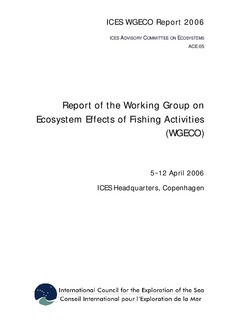| dc.description.abstract | It has been several years since ICES has completed a comprehensive review of the effects of fishing on the North Sea ecosystem, and this year our ToR (Section 3) has allowed us to revisit this important topic. We have reviewed the impacts of each of the major gears in terms of their effects on all components of the ecosystem, and for the first time since 1995 have described the international distribution of fishing effort of beam trawls, otter trawls (including seine gears), and small-meshed fisheries throughout the North Sea. Compilation of such data at an international level, and at the scale of the ICES rectangle, was a frustrating task and was fraught with problems of data compatibility and quality. ICES will need to plan carefully if such an advisory request should come from an external customer, and in section 7 we consider ICES readiness to provide advice to the Regional Advisory Councils, and have included lessons learnt from our work on this ToR.
Last year WGECO identified the need for fully Integrated Ecosystem Assessments to link manageable human activities with the pressures they cause in the marine ecosystem. The matrix of pressures and components of the ecosystem provides a useful tool for prioritising the key interactions in the ecosystem, and a weighting system was developed based on the spatial
extent (local or widespread) and intensity of the interaction (chronic or acute) (section 4).
Indicators which might be appropriate for managing the human activities responsible for these
pressures were identified.
In our 2005 Report we presented a detailed analysis of how ecosystem effects of fishing could
be included into the provision of routine fisheries advice. In turn, SGMAS considered our
proposals and Section 5 continues this dialogue. We identify ecosystem considerations that
should be taken into account in an ecosystem approach to fisheries management, and suggest
that these should be part of routine activities not an optional extra. WGECO feels that this
would be an attitude consistent with good risk management practices applied in many other
fields. Where knowledge or data are inadequate, we clarify the work that needs to be
undertaken so that improvements can be made.
WGECO has advised on the development and implementation of the Ecological Quality
Objective (EcoQO) approach in OSPAR for several years, and feels that ICES is now in a
position to provide clear advice on a way forward with implementing the EcoQO on changes
in the proportion of large fish in the fish community (section 6). This EcoQ element, as
measured in research trawls, is a useful indicator of the effect of fishing, a useful state
indicator for the fish community and is indicative of wider changes in the biodiversity of the
ecosystem. WGECO concluded that the EcoQO can be further progressed as part of an
objectives-based management framework and so has defined a goal for the fish community to
Halt as rapidly as possible, and begin to reverse by 2010, both the decline in the mean weight
and the proportion of large fish . Large fish were defined as those greater than 30cm in
length, and short, medium and long-term operational targets were suggested. In the short-term
it is suggested that the decline in proportion of these fish size measures in survey catches
should be halted immediately. In the medium term, targets for fish size should be based on
the time necessary to restore fish populations to conditions in the early 1980s when ICES
generally considered stocks to be sustainable. In the longer term, targets could be revised
using improved information on the ecological consequences of an over-fished fish community
and societal choices for more or less ambitious conservation objectives. ICES have begun a dialogue with the Regional Advisory Councils (RACs) to develop an
understanding of their requirements for advice and how this advice might be provided. In
section 7 we provide a summary of the ecosystem effects of fishing for all components
relevant to the North Sea RAC (based on work in section 3), and extend this approach to the
other RACs. Although not comprehensive, it highlighted the many interactions between fisheries and ecosystems for which ICES lacks knowledge to provide quality advice. While
many effects can be generalised across the region, most specific studies relate to the North Sea
and Baltic Sea, and in many cases, the extent of the effect will depend on the nature and scale
of the fishing activity in an area. ICES currently lacks the capacity to deal with
geographically referenced data and this skill will become increasingly important as advice is
requested on a range of geographically-related fisheries management measures.
This year WGECO continued to assist the Regional Ecosystem Group for the North Sea
(REGNS) in their work on an Integrated Assessment (section 8). In our review of the dataset
used by the working group we found a number of inconsistencies and anomalous data entries
which may have affected the outcome of their analyses. We also reviewed the coverage of the
ecosystem components in the database supplied to us and suggested taxa and components
which have important roles in ecosystem function, and which could be used in future.
Comments were also made on the analytical approach adopted by REGNS to encourage wider
discussion of the methods used for Integrated Assessment and in their later thematic
assessments. | en |
